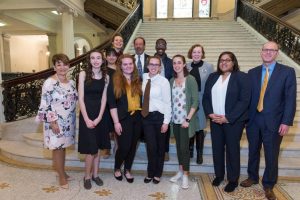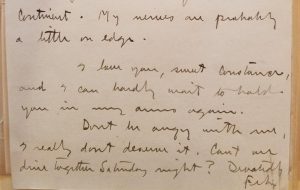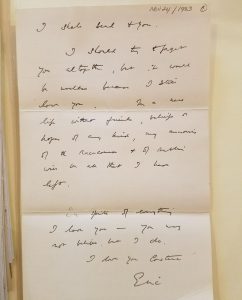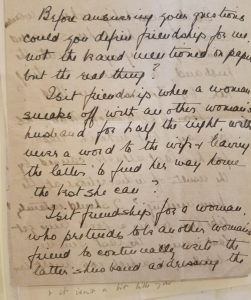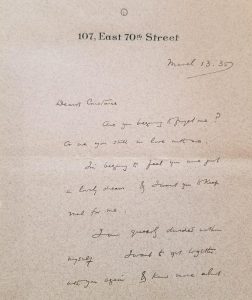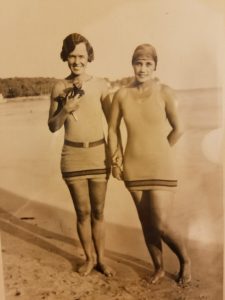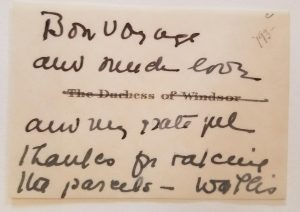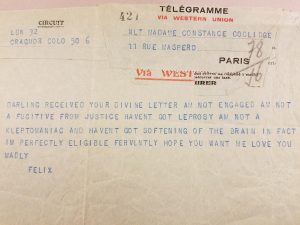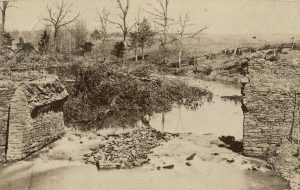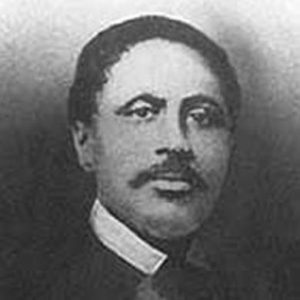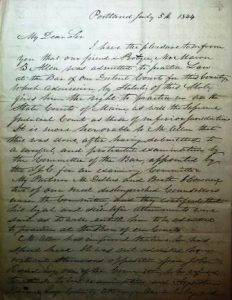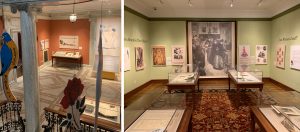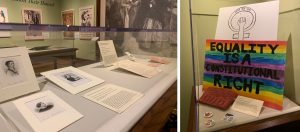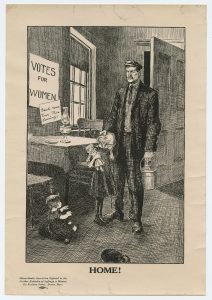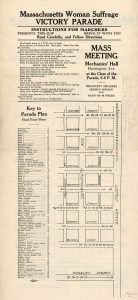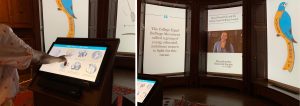By Anna Clutterbuck-Cook, Reader Services
Today, we return to the diary of George Hyland. If this is your first time encountering our 2019 diary series, catch up by reading the January, February, March, and April 1919 installments first!
As the growing season commences in earnest, George’s labor increases and diversifies beyond chopping and hauling wood. In May he spends time at multiple households mowing lawns, trimming walks, planting flowers, pruning trees, and weeding vegetables. In addition to being paid in cash, he also earns half a rhubarb pie, half a jar of pear preserves, and ten doughnuts. He is also often fed dinner and supper, and nearly always tea with milk. His routine is punctuated in May by a trip to Boston on the 6th, where he does some banking, eats lunch at a restaurant near Rowe’s Wharf, and catches an airshow above Boston harbor. “They turned over,” George reports, “made summersaults (end over end) dove down straight, and went up straight in the air. Some of them dove down in spiral form. When they were very high in the air they looked like a flock of hawks.”
Without further ado, join George on his daily rounds during May 1919.
* * *
PAGE 329 (cont’d)
May 1. Par. clou. to cloudy. W.S., S.E. a few sprinkles in aft. Worked 5 1/2 hours for A.E. Litchfield improving […] 11 1/2 hours in all. 300. Called at Uncle Samuel’s late in aft. had supper there. Grace Whiting (nee Lee) and little girl there. Stanley Dorr called there to take them home in auto. He has lately returned from California. Light rain in eve.
2d. Fine weather tem. 44-66; W.S.W. In aft. worked 2 1/4 hours for Mrs. Salome Litchfield — dug up garden. Late in aft. went to N. Scituate — called at Charlie’s. Had supper there. Walked down and back. Fine eve. N. Light’s in eve. Conj. of Venus and moon.
3d. Worked 5 hours or Mrs. Salome Litchfield — 7 1/4 hours in all — 1.75. Early in eve. went to N. Scituate. Got some eggs there for Uncle Samuel — He gave me 10 cts. Mrs. S. L. gave me 1/2 jar of pear preserves and 10 doughnuts.
4th. (Sun.) Warm weather; W.S.; tem. 54-76. Clear to par. clou. Eve. par. Clou. 11:30 P.M., Lightening N. of here. Cloudy.
5th. Worked 7 1/4 hours for Walter and Mrs. Emma H. Sargent (nee E.H. Bailey) — 210. Helped Mrs. S. make a garden — round garden — about 11 ft. in circum. Then I mowed the lawn, trimmed the grass around the house, then worked on the driveway. Wheeled off 1 load of sod and about 10 loads of stones and coal cinders. Had dinner there. Walked down ret. — rode 1 3/4 miles with Lemuel Hardwick — in auto. Very warm weather, tem. 48-86; W.S.W. wind changed to N.W. about 6:40 P.M. Light rain, did not get very wet. Thunder tempest S. of here in eve. E.F.S. very […] 10:45 P.M. par. Clou. […]
6th. Went to Boston. bought a $50 U.S. Bond — (5th) Victory Liberty Loan. Paid $10 to-day — will pay the balance $40 as soon as I can. got my 4th L.B. to-day at the state St. […] Bank. Walked to N. Scituate then rode to Black Rock Sta. (Cohasset) with Harry Pratt, then tr. to Boston on tr. return went to Pemberton (Hull) on the Steamer “Betty Alden” (725 tons) then tr. to Nantasket. Staid there about 1 1/2 hours then walked to N. Cohasset then tr. to N. Scituate — rode 1 3/4 miles with Arthur E. Litchfield. Had supper at Uncle Samuel’s. While at Nantasket I visited Paragon Park. Had lunch at Plakia’s restaurant off Rowe’s Wharf. Clear. Very cool — tem. 47-54. W.N.E., S.E. Eve. clear. Very cool. 7 aeroplanes were in the air over Boston. They had a sham battle in the air — They turned over, made summersaults (end over end) dove down straight, and went up straight in the air. Some of them dove down in spiral form. When they were very high in the air they looked like a flock of hawks. Most of them were sea planes, and came there from the Sta. at Chatham, Mass. Saw the Met Line Stem. “North Land,” and Stem. “Gov. Dingley.”
7th. Weeded and hoed rhubarb plants 6 hours for W.O.Clapp. […] par. clou. to clou. W.S.W. began to rain about 3:30 P.M. Shower at times. tem. To-day about 40-62.
8th. Weeded and hoed rhubarb plants 7 hours for W.O.C. — had supper there. Cool. W.N.W.N.E. Saw a Star Shell in eve. Same as used in the late war to light […].
PAGE 330
May 9. Weeded and hoed rhubarb plants 6 1/2 hours for Will Clapp. Par. clou. to cloudy; W.N.E., S.E. Very damp eve. par. clou.
10th. Weeded and hoed rhubarb 5 1/2 hours for W.O. Clapp. Forenoon cou. very damp. cold. W.E. began to rain about 3 P.M. rain all eve W.E.
11th. Cold storm — rain all day and eve.; W.N.E.; tem. About 38. Early in eve. went to Fred Litchfield’s and bought 2 loaves of bread. Cold and windy day and eve.
12th. Cold storm, light rain all day and eve. W.N.E. tem. 48. Chopped wood (in woodhouse) 2 1/2 hours for Mrs. Salome Litchfield — 40. Had dinner there. 11:15 P.M. still raining. Windy.
13th. Weeded and hoed rhubarb plants and carried off the weeds and grass (dog grass) 3 1/4 hours for W.O. Clapp — 28 1/4 hours in all — 7.00. Late in aft. went to N. Scituate rode 1 mile with Archie Mitchell — ret. rode 1/3 mile with Liba Litchfield and 1 1/4 mile with a man in auto (a Russian). Fine weather, clear; W.N.E., S.E., tem. About 44-52. Fine eve.
14th. Worked 7 1/2 hours for Mrs. Ethel Torrey (nee Speare) on flower gardens and front walk. 2.25. Carried my dinner. Walked down — ret. rode to Comcasset Hall with Henry Newcomb — then rode 1/2 mile with Frank Bates. Warm weather, W.S.W.; tem. 55-80. Wind changed to N.E. late in night. Cold and windy. Mrs. Emma Sargent stopped where I was working and said she would like to have me work for her to-morrow. [half a line scratched out]
15th. Worked 6 hours for Mrs. Emma Sargent — mowing lawn, trimming walks and […] she worked with me — is a very nice gardener. X 180. Carried a lunch — she gave some tea, milk, and other things. Rode down with Mr. Samuel Benson — junk dealer. ret. rode 1 3/4 miles with Albert Litchfield. Cold and windy. tem. About 40-6. W.N.E. gave Mrs. Ethel Torrey 2 Canterbury Bell, and 2 foxglove plants — carried them there this A.M. and transplanted them for her. Bought a new watch yesterday at Mrs. Seavern’s store. 1.25. Belva C. Merritt wound and set it for me. Eve. cloudy. cold. W.E.
16th. Fair W.N.E., S.E., tem. clou. 48-58. In aft. Worked 4 hours for Mrs. Salome Litchfield — cleared up a very large grape vine (cut it all down) and trimmed a cherry tree. — 100. Eve. cloudy; W.S.E. very damp. Some fog.
17th. Worked 5 ½ hours for Mrs. Emma F. Sargent — 1.65. Had dinner there. Cloudy until about 9:30 A.M., W.S.E. Aft., fair; W.S.W. windy. tem. About 46-68. Walked down — ret. rode 1 1/4 miles with Galen Watson in auto. Had supper at Uncle Samuel’s. Began to rain about 6:30 P.M. Rain all eve. Thunder storm S. of here. Mrs. S. worked with me in garden.
18th. (Sun.) Fine weather, clear; tem. About 47-67; W.S.W., N.W.
19th. Worked 4 hours for Mrs. Salome Litchfield — 1.00. Fine weather, tem. About 50-69; W.N.W.; S.W.; clear. Made a trellis for grape vines and did other work. B.D.P.B.B. 2W. Fine eve. Mrs. S.L. gave me 1/2 rhubarb pie — gave me a plate of mashed potatoes.
20th. Worked 6 hours for Mrs. M.E. Seaverns chopping up boxes, barrels, etc., and mowing lawn, trimming grass in front of house and store — 1.80. Fine weather. W.N.W. in forenoon — S.E. in aft. tem. About 48-69. Carried a lunch — Mrs. S. gave me some tea and milk. Walked down — ret. rode 1 1/2 miles with Hubert Harriman. Fine eve. Paul spent eve. Here. 11 P.M., clou., W.S.E.
21st. Worked 6 hours for Mrs. Seaverns — mowing, chopping up old barrels and housing the wood, made a garden and transplanted 3 foxglove, 3 Canterbury bell, 3 Hollihock, and about 15 cornflower plants (from my garden) — for Mrs. S. — 1.80. Mrs. Emma Sargent and her mother Mrs. Bailey called to see if I will work for Mrs. B. Walked down. — ret. — rode 1 mile
PAGE 331
with Margaret and Mother Brown in auto. Cloudy, damp. W.S.E. Carried my dinner. Eve. clou., foggy; W.S.E. to E. rain in night.
22nd. Rainy nearly all day. W.S.E.
May 21. Sergt. Alvin C. York, Co. 328th Inf. (U.S.N.A.) […] in New York. While he as in the great war (about 6 month) he k. 25 Germans, captured 132, and destroyed (or cap.) 32 German machine guns. Was the 82nd U.S. Div. 2nd Corps. U.S. Army. 45 off. And 780 men of the 82nd Div. Arr. to-day — from Fr. 82nd Div. Com. by Maj. Gen. Geo. P. Duncan — he said it’s true about Sergt. York. York belongs in Pall Mall, Tenn. The 82nd Div. is composed of men from Tenn., Ala., and Ga.
23rd. Worked 6 hours for Mrs. M. E. Seaverns — 180. Walked down — ret. rode 1 mile with George Hardwick in auto. Fine weather, W.S.W. to W. Clear. Tem. about […] Have sold 3 hollihock [sic], 3 Can. bell, 3 foxglove, and about 15 cornflower plants [two half lines crossed out] and 1 Calio[…] plants to Mrs. Seaverns — 100. Gave Mrs. Emma F. Sargent 2 Can. bell and 1 foxglove plants — carried them to her this A.M. and transplanted them for her. Carried my dinner. Mrs. S. gave me some tea — with milk. Fine eve. Called at Uncle Samuel’s — had lunch there Mrs. Fernald there.
24th. Worked 7 hours for Mrs. M. G. Seaverns — mowing, raking, grass, trimming around currant bushes and etc. — 210. Very warm and muggy. par. clou. in aft. W.S.W. rode 2 miles with Harry Brown and his mother in auto. H. just arr. from [sic] home from France — has been in the Great War — was in the U.S. Army over a year — in the 306th Field Art. 77th (N.Y.) Div., 2nd Corps. One of the ^best [inserted] Divisions in the army. Carried my dinner to-day. Walked home. Eve. clou. Warm. Light rain at times.
25th. (Sun.) rain at times all day. Thunder tempest S.W. of here late in aft. Eve. clear. W.N.W.
26th Worked 6 1/2 hours for Mrs.Salome Litchfield — 162. Had dinner there. Warm. par. Clou. Very windy. N.W. Eve. par. Clou.
27th. Worked 5 hours for Mrs. Eudora Bailey (Mrs. Emma F. Sargent’s mother) — 100. Walked down ret. rode back with Albert Litchfield. Fair. Warm and damp. Carried my dinner — Mrs. Bailey gave me some tea and milk. Paul s pent eve. here.
28th Worked 5 hours for Mrs. Bailey. 100. Fine weather. Clear. W.S.E. rode 2 miles with Albert Litchfield — ret. rode 2 miles with Lemuel Hardwick — in auto. Stopped and worked 1/2 hour on father’s lot in Mt. Hope Cem. fine eve. Hired box no. 2, at N. Scituate P.O. paid $300 due to the So. Scituate Bank — paid $800 for rent of the James place for June 1919. Have hired the place. Did all these things this A.M. — before I went to work. Carried my dinner — Mrs. B. gave me some tea and milk. […] in eve.
29th. Worked 6 hours for Peter W. Sharpe — mowing in X field, helped him spray his orchard and set up 30 bean poles. Had dinner there, fine dinner. X 150. Very hot weather tem. About 69-92. W.N. to N. W. Walked down ret. road near home with Margaret E. Brown in auto. last part of the way. Eve. hazy. An aeroplane passed over the house about 7 P.M.
30th. (Decoration Day) Worked 2 hours for Mrs. M. G. Seaverns — 60. Also worked some on the James place — in garden. Walked down. Late in aft. Went to Hingham Cen. at Henrietta’s — had supper there. ret. to N. Scituate on 7:15 tr. walked home. Walked 12 miles to-day. Went to Mt. Hope Cem. in morning — put flowers on graves of father and mother, grandfather Hyland and grandmother Hyland — also my […] grandmother H. (his 2nd wife), also on aunt Emeline’s grave. Little Esther and Marion’s graves (Emeline’s children), Charlie’s children — (Edward and Olive) and on my great-grandmother’s grave (nee Lois Ellines) —
PAGE 332
and her 2nd husband […] G.A.R. there with band and S. of V. Boy Scouts and Soldiers of the Great War. Fred Jackson, Scituate Cen. Very fine weather, W.N.E., clear. Fine eve. Charles, Lucy, and Daisy on some […].
31st. Worked 7 hours for Peter W. Sharpe. Hoeing garden, potatoe [sic], corn, and pea and tomatoe [sic] plants — 163. Had dinner and supper there. After supper Peter, Nellie, and I moved (poled) some hay and put it all in one large pile. Walked down, rode home with Peter; Ella (Mrs. S.), Margery and Nellie in their auto. Very fine weather, W.N.E. and S.E. clear eve. clear. damp.
* * *
If you are interested in viewing the diary in person in our library or have other questions about the collection, please visit the library or contact a member of the library staff for further assistance.
*Please note that the diary transcription is a rough-and-ready version, not an authoritative transcript. Researchers wishing to use the diary in the course of their own work should verify the version found here with the manuscript original. The catalog record for the George Hyland’s diary may be found here. Hyland’s diary came to us as part of a collection of records related to Hingham, Massachusetts, the catalog record for this larger collection may be found here.

